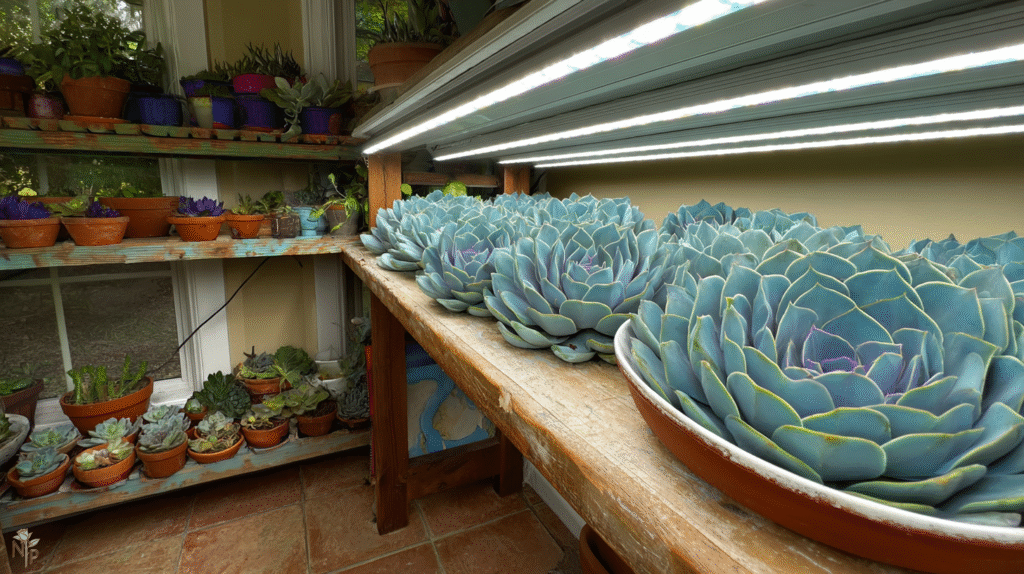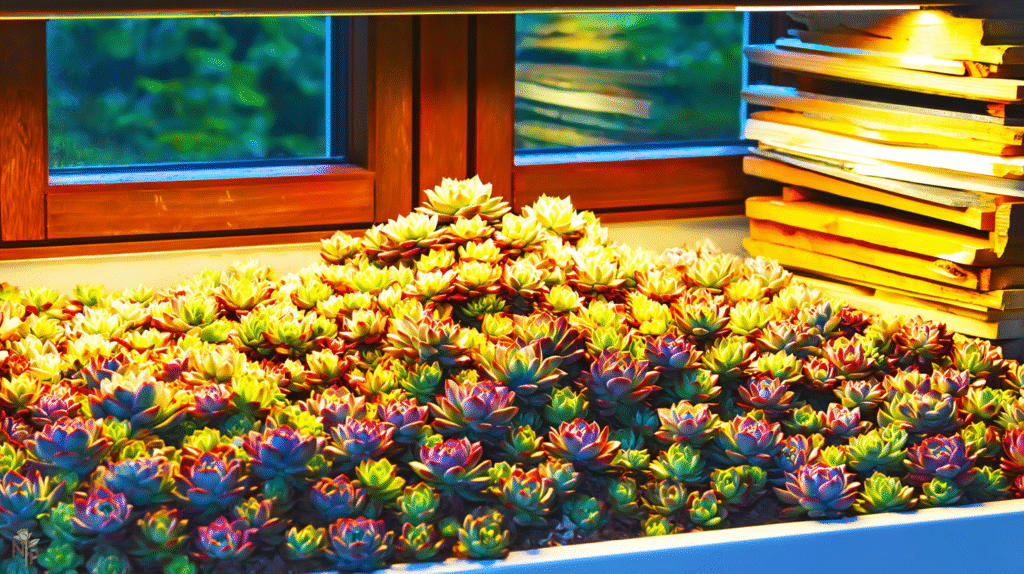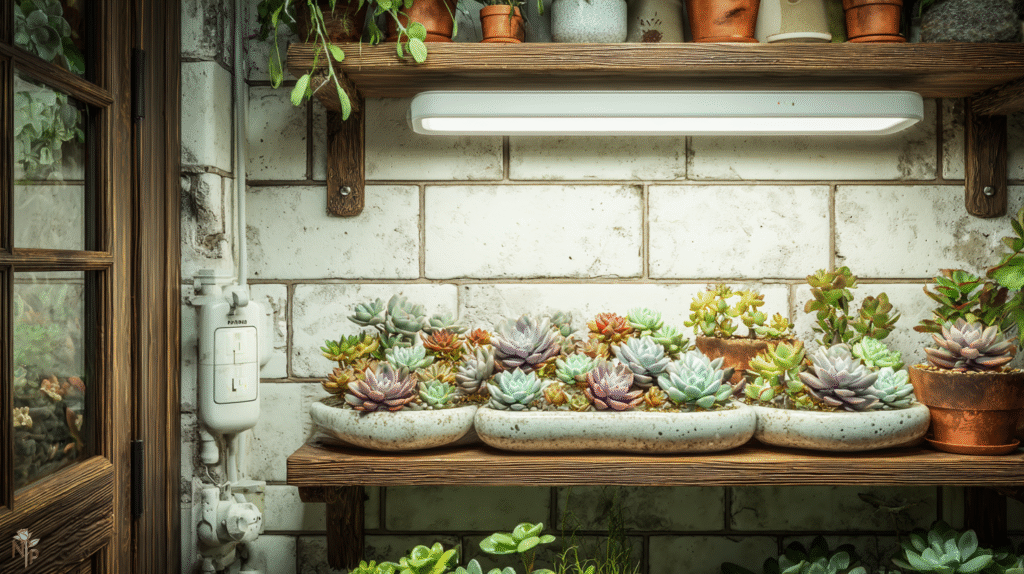My succulent addiction started innocently enough. One cute echeveria from Target. By winter, I had thirty succulents crammed onto my single south-facing windowsill, all stretching toward the weak winter sun like desperate zombies. Half were losing color. The “compact rosettes” looked more like palm trees.
“They need more light,” everyone said. “Just get a grow light!” they chirped, like it was that simple.
Three returned Amazon purchases and $200 in various lights later, I finally understood why my first attempts failed. Not all grow lights are created equal, and succulents are pickier about their artificial suns than I ever imagined. Here’s everything I learned about choosing grow lights that actually work — not just the ones with good reviews.
Why Your Succulents Are Secretly Screaming for Light
First, let’s talk about why that “bright” windowsill isn’t cutting it. Succulents evolved in places where the sun literally tries to kill everything. They want:
- 12-14 hours of intense light daily
- 2000-3000 foot candles minimum
- Full spectrum light including UV
Your window provides:
- Maybe 4-6 hours of filtered light
- 200-500 foot candles on a good day
- UV blocked by glass
My “full sun” south window? Measured it with a light meter — 400 foot candles at noon in winter. No wonder my succulents looked depressed.
The Grow Light Options That Actually Work
After my expensive education, here’s what actually keeps succulents happy:
Full Spectrum LED Panels
My go-to for serious collections. The VIPARSPECTRA P1000 transformed my sad windowsill into a succulent paradise. Yes, it looks like I’m growing something illegal. No, I don’t care. My echeverias are compact and colorful again.
- Covers 2×2 feet effectively
- Actual wattage: 100W
- Cost: ~$70
- Electric bill increase: Maybe $5/month
LED Bulbs in Regular Fixtures
Perfect for beginners or small collections. I use Sansi 36W full spectrum bulbs in cheap clamp lamps. Not as powerful as panels but way better than windows.
- Good for 4-6 small plants
- Fits standard sockets
- Cost: $25-30 per bulb
- Looks less suspicious than panels
T5 Fluorescent Fixtures
Old school but effective. I have these under shelves. Great for spreading light over long areas.
- Good for shelf setups
- Bulbs need replacing yearly
- Runs warmer than LED
- Initial cost lower, long-term higher

The Specs That Actually Matter
Forget the marketing nonsense. Here’s what your succulents care about:
Wattage Reality
“1000W Equivalent!” usually means 100 actual watts. Look for true wattage draw. My succulents need minimum:
- 20-30W for a few plants
- 50-100W for a collection
- 100W+ for multiple shelves
Light Spectrum
“Full spectrum” is overused. Look for:
- 4000K-6500K color temperature
- Red and blue wavelengths included
- Some UV is bonus (most LEDs lack this)
Coverage Area
Manufacturers lie. That “4×4 coverage” light? Maybe for lettuce. For succulents:
- Divide claimed coverage by 2
- Keep lights 6-12 inches from plants
- Closer = more intense light
PPFD (If You’re Serious)
Photosynthetic Photon Flux Density — how much usable light hits your plants:
- 200-400 for most succulents
- 500+ for high light varieties
- Most windows: under 100
My Expensive Mistakes So You Don’t Repeat Them
The Purple Blurple Disaster Bought cheap red/blue LED that made my room look like a nightclub. Plants grew okay but I couldn’t see their actual colors. Returned after a week of purple headaches.
The Weak Strip Light Situation Those adhesive LED strips for $20? Might as well use a flashlight. Zero impact on succulent growth. Now lighting my kitchen cabinets instead.
The Too-Good-To-Be-True Panel “2000W” grow light for $40. Actual draw: 50W. Coverage: about 1 square foot effectively. My succulents laughed at it. Lesson: you get what you pay for.
The Distance Disaster Hung my first good light 3 feet above plants because I was scared of burning them. Result: still stretchy succulents. They need intense light CLOSE.

Setting Up for Success
Distance Guidelines I Actually Use:
- LED panels: 12-18 inches
- LED bulbs: 6-12 inches
- T5 fluorescent: 6-10 inches
- Adjust based on plant response
Timing That Works:
- 12 hours minimum
- 14-16 for best growth/color
- Timer is mandatory (I forgot once, 24-hour light stressed them)
- Consistent schedule matters
The Rotation Ritual: Even with grow lights, rotate plants weekly. Otherwise one side grows more. Learned this after my echeveria developed a serious lean.
Reading Your Plants’ Light Feedback
Your succulents will tell you if the light is right:
Too little light signs:
- Stretching (etiolation)
- Pale colors
- Leaves pointing down
- Wide spaces between leaves
Just right signs:
- Compact growth
- Vibrant colors
- Slight stress coloring
- New growth stays tight
Too much light (rare but possible):
- Bleached spots
- Closing up tightly
- Brown patches
Most people err on too little. I’ve only burned succulents once, and that took serious effort.
Budget-Friendly Solutions That Work
Starter Setup ($50-75):
- 2 Sansi bulbs + clamp lamps
- Covers 6-8 plants well
- Timer outlet
- Good for windowsill supplement
Intermediate Setup ($150-200):
- Small LED panel (100W actual)
- Covers 2×2 feet
- Wire shelving unit
- Room for expansion
The “I Have A Problem” Setup ($300+):
- Multiple panels or T5 fixtures
- Multi-tier shelving
- Individual timers
- What my spare room looks like now
Specific Recommendations by Situation
For Apartment Windowsills: Sansi or GE full spectrum bulbs in architects lamps. Clamp to shelf above plants. Discrete and effective.
For Shelving Units: T5 fixtures or LED strips designed for growing. Barrina T5 lights are my budget favorite.
For Serious Collections: LED panels. Spider Farmer, Mars Hydro, or VIPARSPECTRA. Yes, they’re marketed for other plants. They work great for succulents.
For Plant Rooms: Multiple panels on adjustable hangers. This is where I am now. No shame.
The Transformation Timeline
Week 1-2: No visible change. Don’t panic or move lights closer.
Week 3-4: New growth appears more compact. Colors start improving.
Week 5-8: Dramatic difference. Stretched plants show tight new growth. Colors pop.
Month 3+: Plants look like different species. Compact, colorful, sometimes flowering.
My saddest etiolated echeveria ‘Lola’ went from 6-inch stretched mess to compact 3-inch rosette in four months under proper lights. Same plant, completely different appearance.

Energy Costs Reality
Let’s talk electric bills because I was worried too:
My setup:
- Three 100W LED panels
- Two 36W bulbs
- Running 14 hours daily
- Cost: ~$15/month
Compare to:
- Dead succulent replacement: $5-20 each
- Therapy for plant-related sadness: Priceless
The energy cost is negligible compared to constantly replacing stretchy, dying succulents.
The Bottom Line on Grow Lights
That first winter watching my succulents slowly stretch and fade nearly made me give up on them entirely. Now? My spare room looks like a succulent greenhouse. My electric bill is slightly higher. My plant satisfaction is through the roof.
Start simple. One good LED bulb can transform a small collection. Those stretchy, pale succulents you’re about to toss? Put them under proper light and watch the magic happen. New growth will be compact and colorful. It won’t fix old stretched growth, but propagate the tops and you’ll have beautiful plants again.
My advice? Stop believing your windowsill is enough (unless you live in a greenhouse). Get at least one grow light. Your succulents are desert plants forced to live in dim boxes — give them the artificial sun they’re begging for. Trust me, the transformation is addictive. Just ask my thirty thriving succulents and my very understanding partner who now navigates around grow lights to get to the guest room. 💡






